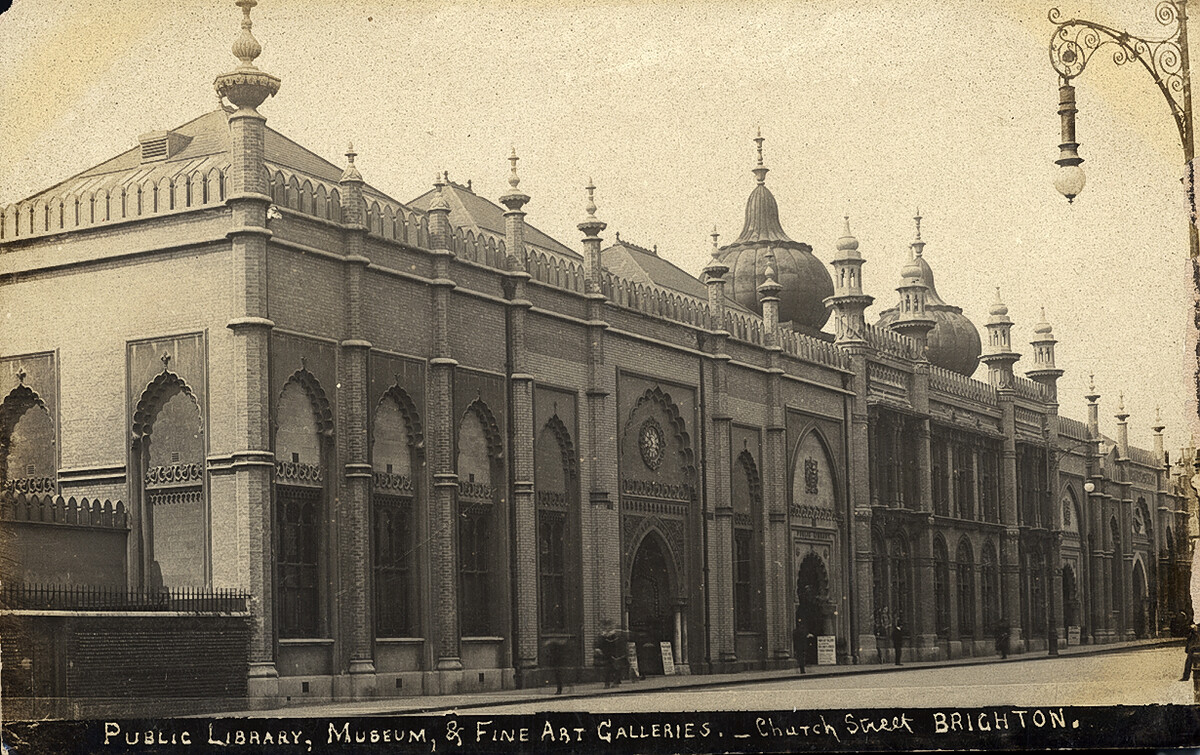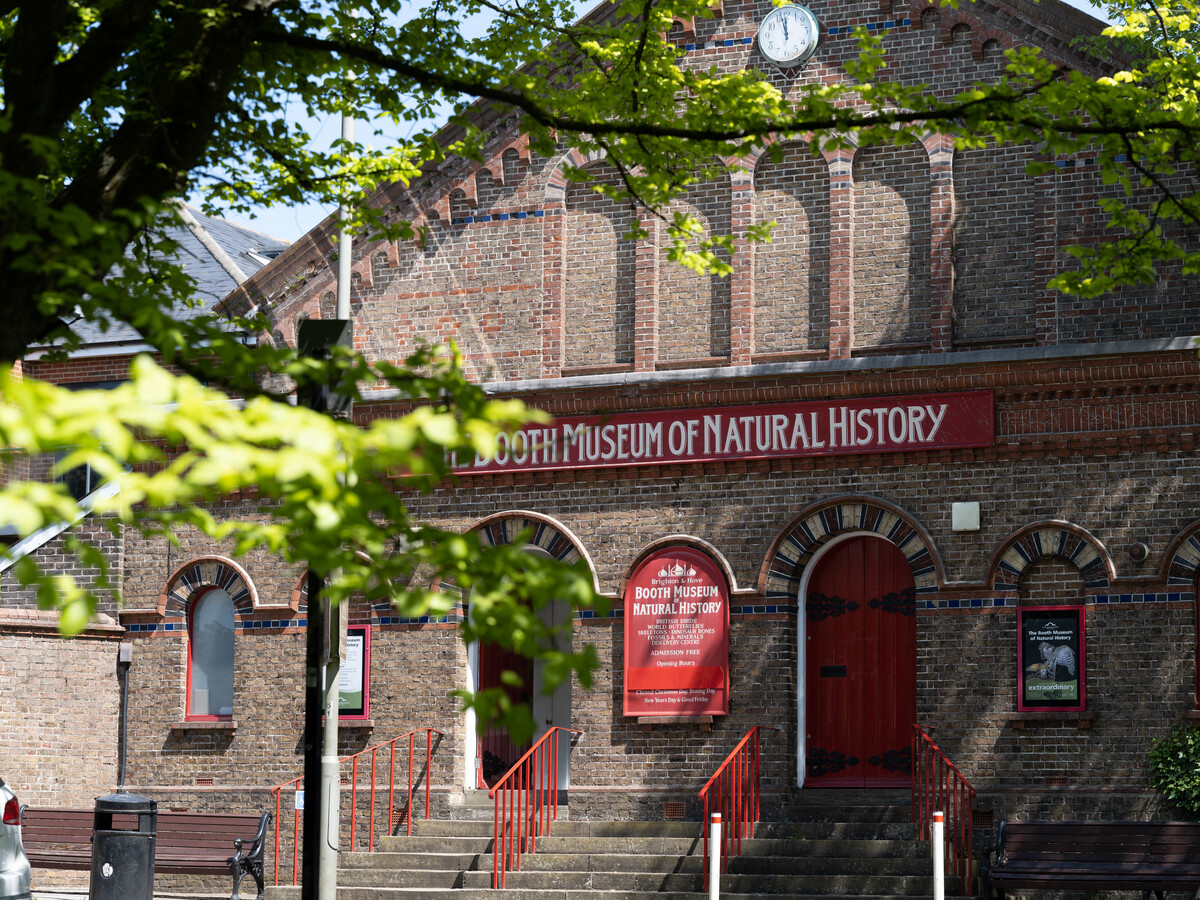
Goal Power! An Exhibition Legacy: Video





This is a legacy story from an earlier version of our website. It may contain some formatting issues and broken links.
Friday 29th July was the Day of Archaeology 2011. It provided the opportunity to find out all about the world of archaeology, with 400 archaeologists blogging about their work. So, with this in mind, here’s a look at a local discovery revealing another slice of Brighton’s history.
[slideshow]
In 1884, during the building of St Luke’s Church hall in Exeter Street, two adult male burials were uncovered with grave goods including shield bosses and spear heads. Later, in 1893, three shield bosses and a sword unearthed in Stafford Road were presented to Brighton Museum & Art Gallery. These discoveries suggested the existence of an Anglo-Saxon cemetery in the area.
In 1985, building works at a house off Stafford Road triggered an archaeological rescue operation when workmen uncovered more Anglo-Saxon burials. Over a Bank Holiday weekend, the remains of three skeletons were uncovered, two male and one female, all dating from around the 6th Century AD. One of the males had died aged about 30 from a serious head wound inflicted by a sword and his skull also exhibited an earlier healed head wound from which he had survived. He was buried with his shield, spear and possibly an iron knife. There is no evidence of cause of death for the other male, aged about 35-40. He was fairly tall at 5’ 11” and robust, although his dental health was poor, demonstrated by evidence of tooth loss and abscesses.
The female skeletal remains were disturbed and damaged by the workmen. However it was determined that she was aged around 40-45 when she died, comparatively old for the early Anglo-Saxon period, and also had poor dental health. She was buried with objects which were likely of most value to her including two copper alloy brooches, two copper alloy rings and a pair of copper alloy tweezers.
Life for these early Saxon settlers appears to have been relatively short-lived and sometimes pretty brutal. Suffering a violent death was not uncommon and life expectancy beyond the age of 40 appears to of been rare. The deficient dental health of two of the skeletons indicates a fairly poor diet and lack of personal hygiene, all of which would have increased vulnerability to disease. This small insight into life in Brighton during the early Anglo-Saxon period suggests it may have been at times somewhat bleak.
Andy, Volunteer Local History & Archaeology

This is a legacy story from an earlier version of our website. It may contain some formatting issues and broken links.
On Thursday 5 May registered electors in Brighton & Hove will have the chance to vote in both a local election and a national referendum. The decisions they make will determine the way the city is run for the next four years, and will shape the way future national governments are elected. As a voter, it can seem like a heavy responsibility. But as you pause at the ballot box, spare a thought for the young man depicted in this painting.
Harry Morley’s Judgement of Paris tells of an episode in Greek mythology that had fatal repercussions. Paris, a prince of Troy, had been abandoned as a baby after his father, King Priam, learned of a prophecy that he would cause the downfall of Troy. Raised as a shepherd, Paris’s innate nobility surfaced in an unusual sense of fairness. This reputation came to the gods’ attention when his prize bull was beaten in a contest by the disguised form of Ares, the god of war. Rather than contesting the result, Paris chose to graciously accept defeat.
Zeus, the chief Olympian god, asked Paris to settle a long-running dispute. Years earlier, he had held a banquet to mark the wedding of Peleus and the sea-nymph Thetis. In order not to spoil the occasion, Zeus forbid the goddess of discord, Eris, from attending. Determined to disrupt the event, Eris threw a golden apple into the banqueting hall. The apple was marked ‘for the fairest one’ and immediately caused a squabble. Three goddesses fought over the apple for many years: Hera, the wife of Zeus; Athena, the goddess of wisdom; and Aphrodite, the goddess of love.
Tired of the dispute, Zeus asked the fair-minded Paris to judge. All three goddesses tried to gain his favour with promises. Hera offered him vast kingdoms; Athena proffered wisdom and skill in war; Aphrodite promised him the love of the most beautiful woman in the world. Paris chose Aphrodite.
Although he chose the least martial option, Paris’s decision had devastating consequences. Once restored as a prince of Troy, Paris was granted the love of Helen, the wife of the Spartan king, Menelaus. Enraged, the Greeks raised an enormous army to take Helen back. For ten long years war waged between Europe and Asia. Eventually, Paris was killed and Troy was utterly destroyed.
This episode has proven popular with artists, including Peter Paul Rubens and Lucas Cranach the Elder. It is not merely a famous story, but an incident loaded with dramatic tension. Although a mythical tale, it is a form of tension that many of us recognise. We may not be asked to judge the beauty of goddesses, but we all know of moments when we have faced important decisions. Participating in elections is just one example.
But there is one uncertainty in Morley’s painting. Unlike many artists who have depicted this story, he does not focus on Paris considering his decision. In this work, Paris has clearly made his choice. The shepherd-prince on the left looks past the figures of Hera and Athena towards the back of Aphrodite. Paris has chosen love, but has Morely captured the moment he has made his decision? Or was Paris always committed to the path of love? Was he a floating voter or a man of firm allegiance?
The Judgement of Paris can be seen in Brighton Museum & Art Gallery’s Twentieth Century Gallery. Details of the 5 May elections can be found on the Brighton & Hove City Council website.
Kevin Bacon
Digital Development Officer
Royal Pavilion and Museums

This is a legacy story from an earlier version of our website. It may contain some formatting issues and broken links.
With royal events very much in the news, Brighton itself has seen many royal visits in the past, notably that of Prince William’s great grandparents, the Duke and Duchess of York (later King George VI and Queen Elizabeth), who visited Brighton in 1928.
During May and June of that year, Brighton was celebrating the extension of the borough boundaries which took in Rottingdean and Patcham and the Dyke area. Bonfires were lit, fireworks set off, a pageant took place in Preston Park and a World’s Fair was held at the Dome.To mark the extension of the new borough, two pylons were erected either side of the London Road at Patcham. It was here on 30 May that the Duchess, dressed ‘in bright beige-coloured crepe de chine, with long coat of georgette with a fox fur collar’ laid the foundation stone of the western pylon with a gold trowel.
Lunch was taken at the Dome. The menu included Mousse de Foie Champagne and Filet de Sole Princess de Galle but ended rather disappointingly with fruit salad.
From there the Duke and Duchess went on to the Royal Alexandra Hospital for Children where they opened a new wing. Here they were presented with a doll for Princess Elizabeth (the present Queen) and an inscribed silver key.
Finally, the royal party drove to Devil’s Dyke where a stone seat commemorating the purchase of the Dyke Estate by the Brighton Corporation was unveiled. The Duke dedicated the Dyke ‘for the use and enjoyment of the public forever’.
The following day the Mayor received a letter from the royal couple’s secretary stating that:
‘they will long remember the interesting occasion in which they were privileged to take part, and they send renewed expressions of their good wishes for the success of the celebrations’.
Paul Jordan, Senior History Centre Officer

This is a legacy story from an earlier version of our website. It may contain some formatting issues and broken links.
The Booth Museum in Brighton has been in existence since 1874 when it was simply the Booth Museum of Birds. 100 years later, during the 1970s, it became the Booth Museum of Natural History when the science collections from Brighton Museum & Art Gallery were moved there.
Originally, zoological specimens were displayed in the side galleries on the first floor of Brighton Museum & Art Gallery but between 1903 and 1904 a new gallery (now the Costume Gallery) was built over the present entrance to the Museum. In February 1904 the new Natural History gallery was opened by the Mayor of Brighton, Emile Marx.
The work of reorganising the collection was carried out by Edward Alloway Pankhurst. He had been a secretary to John Ruskin in his youth and was also a close acquaintance of the Brighton collector Henry Willett. Pankhurst was instrumental in encouraging Willett to donate his pottery collection to the Brighton Museum & Art Gallery.
The zoological collection included such items as the skeleton of a Dodo, a species of porcupine globe fish which resembled:
‘a cross between a herring and an air balloon’
and a specimen whose name was the:
‘terror of spelling bee days – the ornithorhynchus, a creature apparently compounded of several animals, like the fearsome things in Mr. Well’s gruesome story The Island of Dr. Moreau’.
The new zoological section included an adjacent gallery for insects which housed specimens of spiders, beetles and butterflies and a gallery for ‘bones’ containing such objects as the skull of an elephant and a rhinoceros.
In his speech, the Mayor stressed that a museum ‘should illustrate the locality in which it was located’ and praised the collections of locally found flints and fossils as well as paying a special tribute to the sub-curator Herbert Toms.
Pankhurst responded to the Mayor by saying that they were keen to find other animals for the collection. He said that if ‘friends in India had a stray lion or tiger, they might send them along’.
Paul Jordan, Senior History Centre Officer

This is a legacy story from an earlier version of our website. It may contain some formatting issues and broken links.
Solicitor, Author, Museum owner, Collector.
The Booth Museum biographical archive has numerous items relating to Frederick William Lucas. These include nine original photographs of his Rottingdean Museum, his original hand written catalogue, a photographic portrait of him and a letter from Lucas to another important Booth Museum figure, Arthur Foster Griffith.
[slideshow]
Lucas dedicated his spare time to running a private museum at his home, Northgate House, in Rottingdean. His principal interest was zoology but he also assembled a vertebrae collection, entirely through purchases, and a rich world cultures collection numbering around 600 objects. The variety of world cultures material reflects Lucas’s fascination with how people around the world used animal produce.
The Booth Museum now cares for his collection of 1,291 catalogued vertebrate specimens. These consist of nine amphibians, 277 birds, 959 mammals, twenty fish and twenty reptiles. The majority of the collection is made up of cranial specimens but there are also articulated skeletons and twenty-three examples of Dodo bones! The collection, particularly the articulated skeletons, formed the basis of the skeleton or osteology gallery at Brighton Museum & Art Gallery until it was moved to the Booth Museum in 1975.
The Lucas collection is fascinating for two reasons. Firstly, Lucas acquired all his objects and specimens through salerooms, dealers, other collectors and sometimes directly from travellers and, secondly, the world cultures material is not only utilitarian but also extremely beautiful.
Lucas wrote the definitive work on North American Powder Horns entitled “Appendiculae Historiae or Shards of History sung on a horn”.
As well as his interests in science, Lucas was a keen musician and artist. After his retirement in 1925 Lucas moved away from Rottingdean and donated almost the entirety of his collection, together with cabinets and display cases, to Brighton Museum & Art Gallery.
Jeremy Adams, retired Assistant Keeper at the Booth Museum

This is a legacy story from an earlier version of our website. It may contain some formatting issues and broken links.
Solicitor, Alderman, Naturalist, Collector.
Arthur Foster Griffith was the son of Dr Griffith, the popular head master of Brighton College, and the brother of the well-known Egyptologist, Francis Llewellyn Griffith.
Griffith donated significant quantities of objects to Brighton Museum & Art Gallery many of which are documented as being collected in Egypt in 1876. The Museum Register suggests that Griffith acted as an agent presenting the Museum with objects obtained from excavations.
Griffith was a member of the Brighton Corporation (Council)and sometimes chairman of the Booth Museum Sub Committee. He edited later editions of the Booth Museum catalogue as well as purchasing and donating many bird specimens for the collections.
The Booth Museum catalogue currently includes 475 specimens collected or purchased by Griffith, including 166 mounted birds, eight bird study skins, one mammal skin and 281 bird eggs. Elsewhere in the collections of Brighton Museum & Art Gallery his donations include archaeology, local history, and decorative art.
Griffith was involved in the design of many of the Booth Museum display cases subsequent to the death of its founder Edward Thomas Booth. A wall-mounted brass plaque in his honour is displayed in the entrance of the Museum.
Griffith’s obituary can be found in the Brighton & Hove Herald, Saturday 6th January 1934, a copy of which can be viewed at the Brighton History Centre.
Jeremy Adams, retired Assistant Keeper at the Booth Museum

This is a legacy story from an earlier version of our website. It may contain some formatting issues and broken links.
On 10-12 March, Hove Town Hall will host the 21st Sussex Beer & Cider Festival. The festival will feature beers from throughout Sussex, but early indications are that only one of these will be brewed in the city. Drinkers attending the festival might be surprised to learn that Brighton once hosted a thriving brewing industry. Breweries such as Kemp Town, Rock and Tamplins once dominated local drinking, but all had vanished by the 1970s.
This magic lantern slide bears evidence of one of those breweries: Smithers & Sons. Its name can be seen high on the wall above the Unicorn pub. Like many pubs, both then and now, the Unicorn was tied to a single brewer, but it may also have been Smithers’ show piece pub. They were certainly near one another: Smithers’ main premises were demolished in 1923 to make way for the Imperial Arcade; the Unicorn was just a short barrel roll away, on the corner of North Street and Windsor Street, in the spot now occupied by Krispy Kreme Doughnuts.
The photograph was probably taken in 1893, shortly before the pub was rebuilt. Perhaps it was commissioned by the brewery to mark the beginning of a new era? After it was taken, Smithers enjoyed considerable success, acquiring the Vallance and Catt brewery in 1913. Yet by the 1920s it was struggling, and was absorbed by Tamplins in 1929. Tamplins was the last of the major local brewers to survive, but it was bought by Watneys in the 1960s and eventually merged into one of the national groups that came to dominate the British beer industry.
Few traces now remain of Smithers or its rivals. But the local beer industry has left a significant legacy in Brighton Museum & Art Gallery. Henry Willett, one of the founders of the museum, made much of his fortune through brewing: the West Street Brewery was a family firm, and later became the Vallance and Catt brewery acquired by Smithers. Willett, a keen collector with interests ranging from fossils to fine art, supported the museum’s earliest displays. Some of these collections were later donated to the museum, and remain on display today, both in the gallery that bears his name and elsewhere.
Kevin Bacon
Curator of Photographs